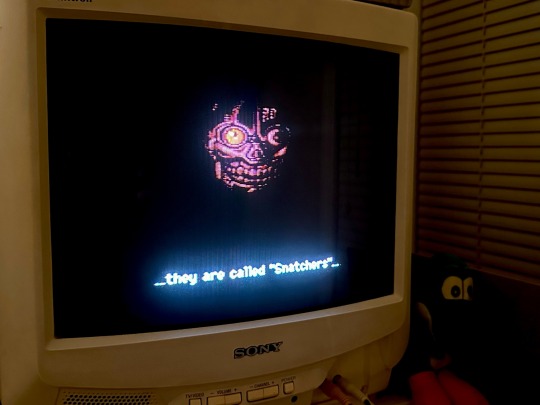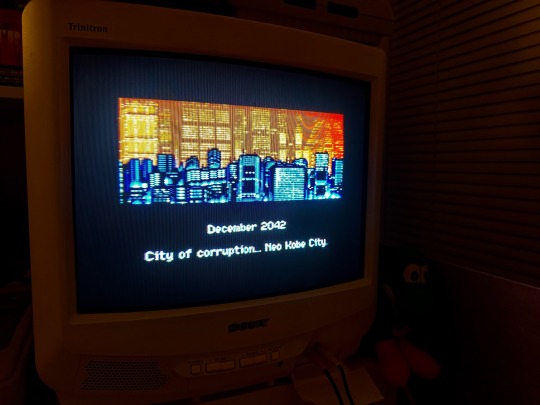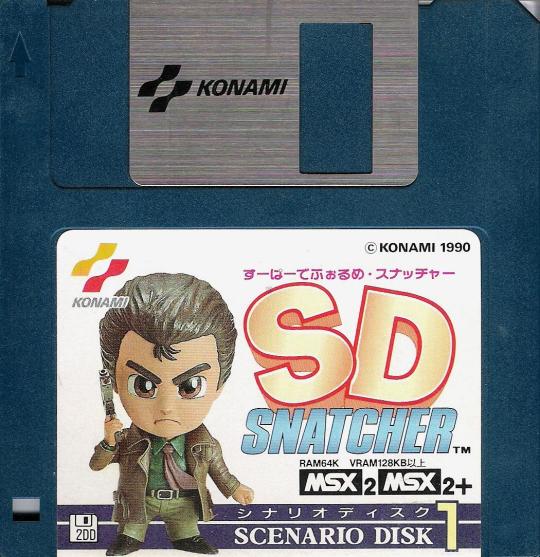#SD Snatcher
Explore tagged Tumblr posts
Note
What's the best way to play Snatcher?
GLAD YOU ASKED... Snatcher has a shocking amount of ports and versions, but the only officially localized one was the 1995 Sega CD version. There is also the MSX2 RPG "SD Snatcher" that elaborates on the main plot of the game and differs in crucial ways... the original game in 1988 for the MSX2 was literally unfinished LOL... it ended on a cliff hanger. Then SD Snatcher came out and finished the plot as a cute RPG game, but then the original game was remade for PC Engine with a rushed Act III tacked on, and then eventually that version was localized for Sega CD.
This is a long way to say you should play both the Sega CD version of Snatcher, and the Project Melancholia translation of SD Snatcher. DM me if you want links to the games and emulators for them.
I think Snatcher is a sleeper classic. Its gameplay is not perfect, but the characters are extremely endearing, the music fucks supremely, and it has some interesting ideas and execution of them which has given it a special place in my heart.
50 notes
·
View notes
Text


SD Snatcher - MSX Magazine, 1990 issue 1
7 notes
·
View notes
Text

15 notes
·
View notes
Text
The forums... sequel and remake speculations...




They give me ideas.
#snatcher#hideo kojima#pc-8801#sega cd#sega saturn#msx 2#konami#retro gaming#SD Snatcher#video games
0 notes
Text



Finally, SD Snatcher on original hardware. Took long enough to set up!
#snatcher#hoping that all goes well#unfortunately i will have to start all over again and this game is incredibly grindy but anything for random
19 notes
·
View notes
Video
youtube
数万円!? 『SDスナッチャー』クリアまで1(SD Snatcher Live Play1)【MSXゲーム実況】#SDスナッチャー #ドグチューブ
0 notes
Photo



SD Snatcher (1990 - MSX2 - Konami)
106 notes
·
View notes
Text


SD Snatcher (MSX2) - April 27th, 1990
#sd snatcher#msx#msx2#konami#RDN98.png#[i was gonna add an extra gif to this but then itd look tiny if i kept it in]#[maybe another time though]
2 notes
·
View notes
Photo

SD Snatcher (1990)
46 notes
·
View notes
Text
Remember that one time I met Slowbeef at MAG while I was cosplaying Fragile and a friend pointed him out telling me "Snatcher shirt!" coz he was wearing one and I was already so so soooo shitfaced so I just shouted at the top of my lungs towards him YYYYYEAAAHHHH SNATCHER BEST GAME IN THE WORLD!!!!!! and so he stopped and turned around and introduced himself and I drunkenly stuttered out thanks to him for helping with the Policenauts translation project + spreading knowledge of Snatcher through his LPs
8 notes
·
View notes
Text

SD Snatcher - Konami, MSX2 - 1990
6 notes
·
View notes
Photo

Finished SD Snatcher the other day as well and I wish I could say it was fun, but really grindy rpgs are just not it for me (Had to use a save editor, which I’m surprised even exists, to make my level manageable). It’s a shame since the battle mechanic of choosing where to aim at your target and lowering different stats based on where you aim feels like a really great idea. I like the mech designs of the enemies in this game a lot though! In general the sprite work is very nice, very charming. I don’t know if I prefer all the story changes from the original snatcher in the part that would cover the first two acts, but they’re not bad either. However I do find myself preferring how act 3 was done in SD snatcher, particularly how it gives elijah a little more depth. The little more we get to see of randam in this is really fun too, they were definitely the highlights for me. All in all really enjoyed the story and the game’s art, but the difficulty level made things more frustrating than fun.
#finn.txt#sd snatcher#snatcher#like genuinely like. I think playing thru both patho's was less miserable than the gameplay before I started using the save editor
3 notes
·
View notes
Text
Hideo Kojima interview with MSX Magazine (2005)
The following is a translation of an interview with Hideo Kojima that was published in a special commemorative issue of MSX Magazine published on May 12, 2005. At the time, Metal Gear Solid 3: Snake Eater on the PlayStation 2 was the latest entry, while the MSX2 entries of the series, Metal Gear and Metal Gear 2: Solid Snake, had just been ported to Japanese feature phones, although they would later be given an international release a few months later through their inclusion in the Subsistence re-release of Metal Gear Solid 3.
In this interview, Kojima talks about his involvement with the MSX development department of Konami and how it shaped him to become the game developer he would become later on and also discusses some of the other MSX games put out by Konami. The original Japanese interview can be found here, which also includes an interview with Metal Gear 2 sound designer Kazuhiko Uehara, which I might post a translation at a later time.
EDIT (2019/6/8): I completely revised the translation of this interview, since I’ve noticed quite a few mistakes that slipped by me after the initial posting. I’m much more satisfied with this version of the translation. I’ve also uploaded my translation of the Kazuhiko Uehara interview, which can be found here.
Disliking The MSX At First
We brought you a present, Mr. Kojima (an MSX Game Reader, an adapter that allows users to play actual MSX cartridges on a PC with an emulator).
Hideo Kojima: Oh, cool! This is truly amazing, isn't it. Nice! (opens box). Are they still selling this?
Sorry, but we're currently sold out. Of course, that one is yours.
But you can't put two cartridges at the same time. [TL's note: Most MSX computers had two cartridge slots. Some Konami cartridges had special features that would be unlocked when played together. For example, playing Gradius/Nemesis with TwinBee on the second cartridge slot would replace the Vic Viper with the actual TwinBee.]
Actually, you can. You'll just need to buy another Game Reader.
Is that so. (while looking at an issue of MSX Magazine) MSX... How nostalgic. How are things going with the MSX?
We were not sure how many copies of the first issue we would sell, but it went beyond our expectations. There are many passionate fans.
There are many developers who came from the MSX. Even in Konami there are many people who would tell me that they joined the company because of Metal Gear. But the truth is that I actually hated the MSX when I joined Konami. (laughs)
Huh, is that so? Now that you say that, there are quite a few people who came to the MSX without ever getting a Famicom bought for them.
But in the end, we would only use it to play games on it... Everything else was done in BASIC. Nowadays I like playing games on it, but I don't use any of its other programs. It's way too complicated for me. But back then there would be many people who would try making stuff on their own.
Why did you hate the MSX at first?
Back in my college days, I thought about joining the game industry since I spent most of my free time at the video arcades. But the MSX hardly crossed my mind. When I joined Konami I was only thinking of doing arcade and Famicom games and I had many ideas for those platforms, but for some reason I was assigned to do MSX games instead. It was difficult (working on the original MSX) since sprites would disappear when you line them up next to each other and the graphics were monochromatic. It was pretty painful.
Did you had to design things yourself too?
It was that sort of era. The development tools were made in-house and after our meeting was over, we would go to a place that was like a design department to use them. The arcade and Famicom departments would also have their designers nearby.
It must had been pretty difficult under those circumstances.
Essentially the MSX couldn't surpass the arcade nor the Famicom. At least not in terms of graphics and sounds. Therefore you had no choice but to be focused on your work. So when it came to the planning, level designs and playability, you really needed someone to be a planner. The MSX division was the only Konami department that had planners. Although a planner is not what you would call an actual profession, they generally served double duty as designers. I started my career as a planner and thanks to the excellent seniors who were there to guide me, I was able to acquire experience that allowed me to make unusual games such as the original Metal Gear.
Using Hardware Limitations To Your Benefit
What brought upon the existence of the original Metal Gear?
I think it can be told now. At the time there was a popular arcade game by Capcom titled Commando, so I was told to make a game similar to that, but on the MSX1. [TL's note: For some reason Kojima mentions the MSX1 specifically, even though the original Metal Gear was released on its successor, the MSX2. I'm guessing he's either misremembering or he's talking about a prototype version that ran on the older hardware. It’s hard to tell.] Back then I think you could only move in six directions. Six directions was going to be impossible, but even reducing it to just four was too restricting. We had no choice but to make a game that could be done without enemies. And that's what allowed me to develop Metal Gear.
Metal Gear's gameplay system used the MSX’s hardware limitations to its own advantage. It’s noticeable during gameplay that there aren't that many bullets on-screen.
They wouldn't come out horizontally either. There were five function keys, so we thought about using each of them. The F4 key for example, would bring up the transceiver. Simultaneously pressing one key and another was unthinkable on a controller.
If I remember correctly, the original Metal Gear didn't cause much of an impact at first, but afterward it started getting a following as word of mouth spread. It was a difficult game to understand at first, but then people ended up acquiring a taste for it.
That's because the company didn't interfere with us too much. At that time, arcade games were still pretty popular and the Famicom boom was in its peak. While the MSX was also popular, we were selling less than the other departments, who were selling millions. But because of that, we were given more leeway to do what we wanted. At the company's cafeteria they would post the five best-selling games for each platform on a board. When it came to the MSX, the top five titles were all games published by Konami. We were proud of that fact, but our salaries were never raised.
We're going to interview Mr. Uehara for this issue too. Did you two work together on Metal Gear?
We worked together not on the original Metal Gear, but its sequel, Metal Gear 2: Solid Snake. I had the most joy in my life during that period. A contrast from the original Metal Gear, which was the most difficult for me. We did Metal Gear 2 for most of 1989, but it wasn't released until 1990. It took a while to come out since our team had to assist in the development of SD Snatcher. It ultimately ended up becoming the last MSX game we ever released.
And then it evolved into Metal Gear Solid on the PlayStation.
When I heard there was going to be a home console capable of 3D polygon graphics, my first thought was "we can finally do a true hide & seek game". We kept the bird’s eye view so far out of reluctance, but I was curious if we were capable of doing stuff like hiding under desks or inside lockers, so we were going to make Metal Gear Solid with a simple set-up, but contents of the game ended up being almost identical to Metal Gear 2. Stuff like “searching the back of the game box [to learn a certain character’s frequency number]”.
Metal Gear Solid was a huge success at the end.
Yes, but the MSX version [Metal Gear 2] was the most interesting.
Konami’s Golden Titles
Snatcher was another memorable game for us.
After I've finished working on Metal Gear, the way people saw me within Konami changed. My status was raised quite considerably, but my salary was still pretty low. (laughs) I didn't know what to do next, so I took a one week vacation and drove to Awajijima with a friend. At that moment I felt like I wanted to make an adventure game like the Portopia Serial Murder Case, a game I was into during my college years. Also, if it was an adventure game, I would've be the one making the vital decisions during development. Working for a game company that specialized on arcade game was tough, since they prioritized programmers.
The original version of Snatcher was the one for the NEC PC-8801.
While planning out Snatcher, Enix put out another game titled JESUS. It was a great game, wasn't it? When I saw [JESUS], I was convinced that I had to develop [Snatcher]for the PC-8801 or it wouldn’t be good. Konami’s condition was that I would also develop an MSX2 version of the game, but I was extremely pleased with that and thought “alright.”
It was the first Konami game developed for the PC-88.
That's right. We had quite a lot of pressure, since we didn't have the tools nor the sales channel. It was ultimately released a year and a half behind schedule. After that happened, we couldn't make the sequel anymore [TL’s note: The PC-88 and MSX2 versions of Snatcher ends the story on a cliffhanger at Act 2. The later console versions added Act 3 as a conclusion, but originally Kojima wanted to do a Snatcher sequel that picks up from where Act 2 left off.], so we ended up going back to the MSX.
The game afterward was SD Snatcher.
That's right.
I wondered at the time why it became SD.
I thought so too. I wondered myself why they were developing such a game. Nevertheless, nobody would’ve known how the story of Snatcher would’ve ended if we didn’t include the rest of it. It would’ve been an awful story.
Space Manbow [a side-scrolling shoot-'em-up released by Konami for the MSX2 in 1989] was another game that we were passionate about.
Initially the game was going to be titled "Alphard" if I’m not mistaken, which didn’t seem like a very marketable name. The game itself was excellent in terms of programming, but something about it didn't seem too interesting. That was when Mr. Akihiko Nagata [the head of the MSX department, who would end up becoming the executive producer of the original Metal Gear Solid.] loudly proclaimed something like "Space Manbow sounds good, doesn't it"? The Manbow [otherwise known as a Ocean Sunfish] was a popular fish back then. The title was decided after everyone said "huh?".
I heard that they had to replace all the characters in the game in around a month.
It was actually supposed to be a port of Thunder Cross [another side-scrolling shoot-'em-up by Konami, released for the arcades in 1988], but the developers ended up becoming too absorbed into their work. At the time Uehara and myself would work together until midnight and since my lodgings were located close to him, I would drive him home there while listening to the music he composed for Metal Gear 2 on the car. We usually had dinner together. We would go to a nearby sushi bar or something, get drunk, have a fight and then we would get up early for work... It was that sort of lifestyle.
I get the impression that the entire staff were lodging together.
That's right. The building in Kobe even had a bath and a gym. I once stayed there for 24 hours. But there were no friends around, even during vacations. I had no choice but to travel alongside co-workers during vacation trips. We were an unhappy bunch.
The Reason Why Konami’s MSX Games Were Interesting
We have a strong impression that the content of Konami's MSX game were thoroughly scrutinized before they were released.
That's because we had planners. That's how our development method differed compared to the other departments at Konami. At the MSX department we would do the packaging, catch-copy, design and manuscripts for a game’s manual all by ourselves. We did everything. It brings me back.
The planner system was the key.
There was this sort-of mentality of “making the player have a game over in one coin” that was borne from an arcade origin like Konami, which resulted in simple games. Those kind of game were really rampant when I joined the company, so I would get angry whenever I was told that I only have a day to come up with the backstory of the game’s world. PC game companies, such as Square and Enix, understood what world-building was about, and that’s where planners like Yuji Horii [creator of the Dragon Quest series] came from, since their development infrastructure were completely different. However, in such situation, the presence of unusual markets such as the MSX, is what I think what Metal Gear made possible, which made me who I am now.
The graphics were pretty too.
At the time our in-house tools were pretty substantial. Not just on the MSX, but also on the arcade and Famicom departments. At the time when other companies were using mouses, we were already using stylus pens. But that wasn’t the reason why our graphics were good. You can still draw poorly even while having decent tools. But afterward, our compression technology would be applied and that’s what made it look good.
How did Konami managed to release so many quality games in a row?
The department at the time evaluated the games thoroughly. We had around four teams, each led by a different planner, and they would evaluate each other's works. If one of them was putting out an uninteresting game, everyone would join forces to fix it. Everyone in the other lines would stop their work and help rebuild the game. This accommodation would last around a month. It was interesting.
Games that are made like that tend to be successful.
They all were. Space Manbow and Hinotori both underwent that process. Treasure of Usas didn't turn out to be very interesting though, even though people helped out on it. SD Snatcher was also completely remade when I got involved. That's why we never put out a bad game. You could say that was our corporate or house style.
Emotional Support From MSX Users
It's not unusual for people to buy games because of the creators involved nowadays, but back then we would buy your games because of your involvement.
Back when the original Metal Gear was being made, Famicom games were selling so well that there was a lot headhunting happening. We were told that we couldn't put our names in the game, but we really wanted to. In the end, we ended up doing so and my name appears as "H. Kojima" on the staff roll [TL’s note: They actually used his full name in Metal Gear. “H. Kojima” was used on the NEC PC-8801 and MSX2 version of Snatcher.]. This practice wasn't allowed elsewhere, but we were forgiven since we were doing only MSX games.
That's how we were able to follow your work.
We would receive survey cards asking "is Kojima-san alright?", but since they only saw my name written in romanized characters, they would write it in kana only or use the wrong kanji characters. They didn't start publishing my face and the kanji for my full name until they released the PC Engine version of Snatcher. In terms of sales, we were outclassed by the Famicom division, so we didn't get much praise, but we sold well enough to be kept around.
But we did your recognize your games.
During the MSX1 era, it would take a pace of 3 months to produce a single game and it was the same thing for the Famicom. Maybe 6 months if they realy took their time. In my case, my projects would've taken a year and a half to complete, which wasn't normal back then. Naturally, nobody appreciate that.
They would complain that you were taking too long.
The sales people around me were kind though. After the release date, I would've received tons of FAX where they would sent me everything. Even if we weren't appreciated in a business sense, we were still recognized thanks to the players and sales people around us.
We are happy to know that you received positive feedback.
The survey cards and letters we've received were always placed in the lounge. I would read them over and over again like I was indulging them. We would also receive chocolate around this period. Nowadays we don't get them that often.
MSX users like us would often argue with the Famicom-owning kids at school. For example, we would brag that the MSX version of Gradius had a long laser, while the Famicom version didn't have that.
That's amazing, but no matter how you put it, the MSX was inferior in terms of hardware and it was expensive at that, wasn't it? But since [MSX users] came from a highly intellectual place, we strongly felt we had to implement various schemes to appeal to them.
Your experience with the MSX is what led you to become who you are now.
It was because of the MSX. At the time I thought "Why must I join the MSX"?, but now I'm truly grateful. I believe the MSX department was really blessed, since I haven't been so for a while.
We are looking forward to your future games. Thanks for the interview.
2 notes
·
View notes
Text
Playing the clunkiest grindiest jrpg on earth that only wants me to suffer bc I NEED to see more of randam. Suffering for love etc etc
#it's a shame I LOVE the design for SD snatcher the sprites are cute and the robot designs are nice#and I'm curious to see more bc I've seen some ppl say the way act 3 is done in sd snatcher is a little better than the sega cd act 3#but literally I think it's a sign that for a game that is so fucken obscure there is still a save editor someone made#and I'm using that to level instead bc otherwise this would be impossible#like I'm sorry but both patho games put together were not this miserable#anyways. I named gillian 'bongwater' bc he deserves it after having to put up with him in snatcher
3 notes
·
View notes
Photo




SD Snatcher
©️ Konami 1990
Image sourced from hardcoregaming101.net See? You guys could’ve gotten Chibi Death Stranding if Kojima was feeling cutesy that day.
15 notes
·
View notes
Text

2022 : Invasion of the Sun Snatchers [Bike Trip : SD]
US Hwy 14, west of Pierre.
8 notes
·
View notes